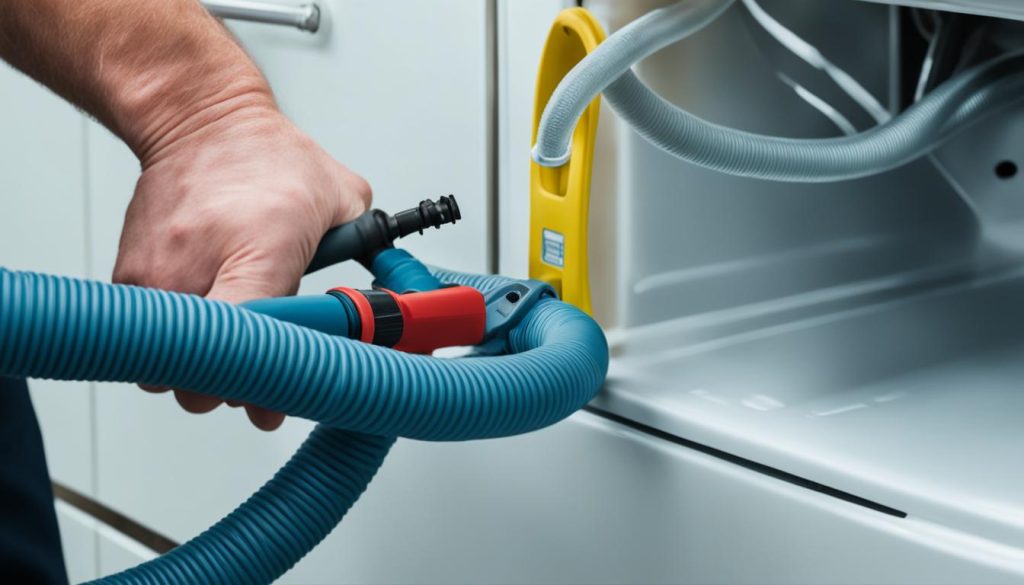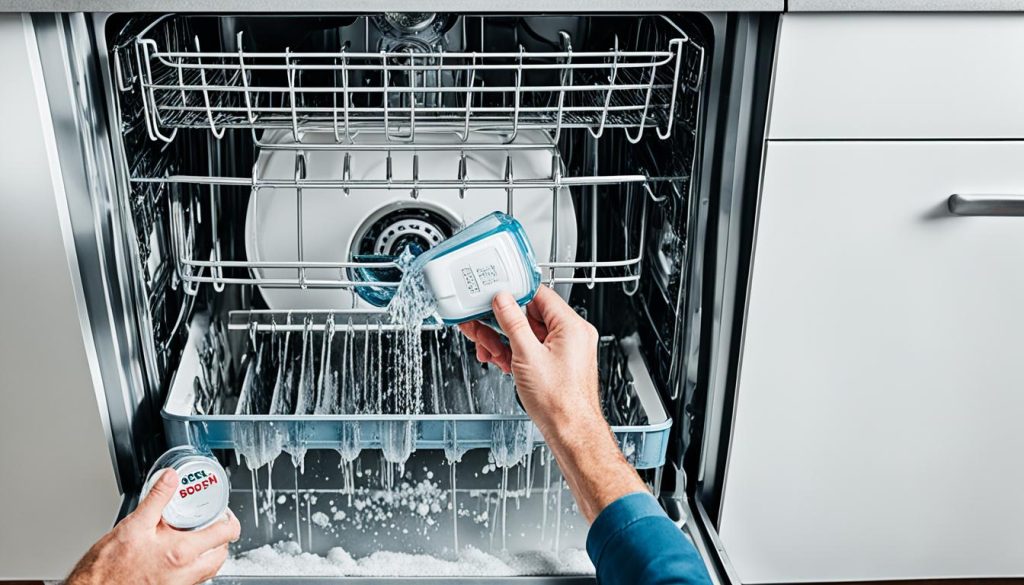Fix It Fast: Force Drain Bosch Dishwasher Guide
You’re in the middle of a busy weeknight dinner, and suddenly you notice something alarming – your Bosch dishwasher is not draining properly. The water is pooling at the bottom, and you’re left with a sink full of dirty dishes. Don’t panic! This issue is more common than you think, affecting numerous Bosch dishwasher owners across Canada.
Key Takeaways:
- Blockages are a common cause of Bosch dishwasher drainage problems.
- Regularly cleaning the filter unit and drain hose can help improve drainage.
- Ensure there are no kinks or twists in the drain hose.
- Using baking soda and vinegar can help clear blockages.
- Follow preventative measures to avoid future drainage issues.
How to Clean the Filter Unit
The filter unit in a Bosch dishwasher can become blocked with food particles, preventing proper drainage. Regularly cleaning the filter can help improve drainage and prevent future issues. Follow these steps to clean the filter unit:
- Remove the bottom dish rack from the dishwasher.
- Twist and remove the circular tube that houses the filter.
- Untwist the cylinder from the filter and use a small brush to wash both the cylinder and filter, removing any debris.
- Twist the filter back into the cylinder.
- Reinsert the filter unit into the dishwasher.
By cleaning the filter unit regularly, you can ensure that your Bosch dishwasher drains properly and avoid any drain pump issues.
Regularly cleaning the filter unit is essential for maintaining the proper functioning of your Bosch dishwasher. It helps prevent blockages caused by food particles and debris, which can lead to drainage problems. By following these simple steps, you can keep your dishwasher running smoothly and avoid the need to force drain your Bosch dishwasher in the future.
How to Unblock the Dishwasher Pump
If the dishwasher pump is blocked, it can cause drainage issues in a Bosch dishwasher. To unblock the pump, follow these steps:
- Start by removing the bottom dish rack to access the pump.
- If there is any remaining water in the dishwasher, use a sponge to remove it.
- Wear protective gloves and use a small spoon to pry off the pump cover.
- Clean out the pump carefully, ensuring to remove any debris that may be obstructing it.
- Once the pump is clear, replace the pump cover and reinsert the filter unit.
Clearing any blockages in the dishwasher pump can help restore proper drainage and ensure your Bosch dishwasher is working efficiently.
For visual reference, here is a table summarizing the steps to unblock the dishwasher pump:
| Steps | Action |
|---|---|
| 1 | Remove the bottom dish rack |
| 2 | Remove remaining water with a sponge |
| 3 | Use a small spoon to pry off the pump cover |
| 4 | Clean out the pump, removing any debris |
| 5 | Replace the pump cover and reinsert the filter unit |
By following these steps, you can effectively unblock the dishwasher pump and resolve any drainage issues you may be experiencing with your Bosch dishwasher.
How to Check and Clean the Drain Hose
The drain hose of a Bosch dishwasher is essential for proper drainage during the dishwashing cycle. If the drain hose becomes kinked, twisted, or clogged, it can lead to drainage issues. To ensure optimal drainage, follow these steps to check and clean the drain hose:
- First, disconnect the dishwasher from the power supply for safety.
- Next, feel along the drain hose for any sharp bends or kinks. Straighten out any bends or kinks you encounter along the hose to ensure a clear path for drainage.
- Carefully disconnect the drain hose from the dishwasher and place the disconnected end into a bucket or basin to catch any water that may be trapped within.
- Inspect the drained end of the hose for any blockages. Feel for any debris or obstructions and remove them.
- Once you’ve cleared any blockages, reconnect the drain hose securely to the dishwasher.
- Finally, run water through the drain hose to ensure it is fully cleaned. This will help improve drainage and prevent any future issues.
Regularly checking and cleaning the drain hose of your Bosch dishwasher is crucial for maintaining optimal performance and avoiding drainage problems.
Diagram: Drain Hose Cleaning Procedure
| Steps | Description |
|---|---|
| 1 | Disconnect dishwasher from power supply. |
| 2 | Straighten any sharp bends or kinks in the drain hose. |
| 3 | Disconnect drain hose and collect any trapped water. |
| 4 | Remove any blockages from the drained end of the hose. |
| 5 | Reconnect the drain hose securely to the dishwasher. |
| 6 | Run water through drain hose to ensure cleanliness. |
How to Clear Blockages with Baking Soda and Vinegar
If you have a blockage in your Bosch dishwasher, utilizing a solution of equal parts baking soda and vinegar can help clear the obstruction.
Mix about a cup each of baking soda and vinegar and pour the mixture into the standing water in the dishwasher.
Run a hot wash cycle with a cup of vinegar in a standing cup placed in the dishwasher.
Then, pour an equal amount of vinegar and baking soda into the bottom of the dishwasher.
If there is still standing water at the end of the cycle, there may be a drainage problem caused by a blockage in the filter or tub.
Note: Visual representation of how to clear blockages with baking soda and vinegar in a Bosch dishwasher.
| Steps | Description |
|---|---|
| Mix baking soda and vinegar | Combine approximately one cup of baking soda and one cup of vinegar. |
| Pour the mixture into the dishwasher | Empty the mixture into the standing water in the dishwasher. |
| Run a hot wash cycle with vinegar | Place a cup of vinegar in a standing cup inside the dishwasher and run a hot wash cycle. |
| Add vinegar and baking soda to the bottom of the dishwasher | Pour an equal amount of vinegar and baking soda into the bottom of the dishwasher. |
Preventative Measures for Avoiding Drainage Issues
To prevent blockages that may cause drainage issues in your Bosch dishwasher, there are several preventative measures you can take:
- Scrape Food Scraps: Before loading dishes into the dishwasher, remember to scrape off any food scraps. This will help prevent debris from clogging the filter or drain hose.
- Monthly Empty Cycle: Run an empty cycle once a month with white vinegar. This helps to clear out any potential blockages and keep the dishwasher functioning optimally.
- Hot Water Cycle: Instead of using cold water, opt for the hot water cycle when running the dishwasher. Hot water aids in breaking down deposits more efficiently, reducing the likelihood of blockages.
- Regular Filter Cleaning: Even if your dishwasher is draining properly, make it a habit to regularly clean the filter. This ensures that any debris or residue is removed, preventing future drainage problems.
By following these preventative measures, you can keep your Bosch dishwasher running smoothly and avoid the frustration of drainage issues.
How to Perform a Reset on a Bosch Dishwasher
If your Bosch dishwasher is not draining and a reset is needed, there are a few methods you can try. For models with a Cancel Drain function, pressing the designated buttons for 3-5 seconds can initiate a reset. If your model does not have a Cancel Drain function, holding the Start button for the same duration can reset the dishwasher. In some cases, disconnecting the power to the dishwasher by unplugging it or turning off the circuit breaker can also reset the dishwasher. Following these reset methods can help resolve drainage issues.
| Reset Method | Instructions |
|---|---|
| Cancel Drain Function | Press the designated buttons for 3-5 seconds to initiate a reset. |
| No Cancel Drain Function | Hold the Start button for 3-5 seconds to reset the dishwasher. |
| Power Disconnection | Unplug the dishwasher or turn off the circuit breaker to reset. |
Troubleshooting Tips and Final Thoughts
If the reset methods and cleaning procedures described above do not resolve the drainage issue in your Bosch dishwasher, I recommend consulting the dishwasher’s manual or contacting a Bosch technician for further troubleshooting. Ignoring drainage problems can lead to more damage and potential water damage in your home.
By following the steps outlined in this guide, regularly maintaining and cleaning your Bosch dishwasher, and troubleshooting as necessary, you can keep your dishwasher draining properly and avoid future issues. Remember to scrape food scraps off dishes before loading them into the dishwasher, run the dishwasher on empty once a month with white vinegar, and use the hot water cycle for better breakdown of deposits.
If you encounter any persisting drainage issues, it’s important to address them promptly to prevent further damage. Consulting the manual or seeking professional help will ensure accurate diagnosis and resolution of the problem. By staying proactive and taking care of your Bosch dishwasher, you can enjoy clean and efficient dishwashing without any drain complications.
- Investing Wisely: How Windows & Doors in Boost Property Value and Financial Health - April 24, 2025
- The Financial Impact of Personal Injuries: Why Legal Help Matters for Business Owners - April 16, 2025
- The Hidden Financial Costs of Domestic Assault: What Business Owners Need to Know - April 16, 2025














